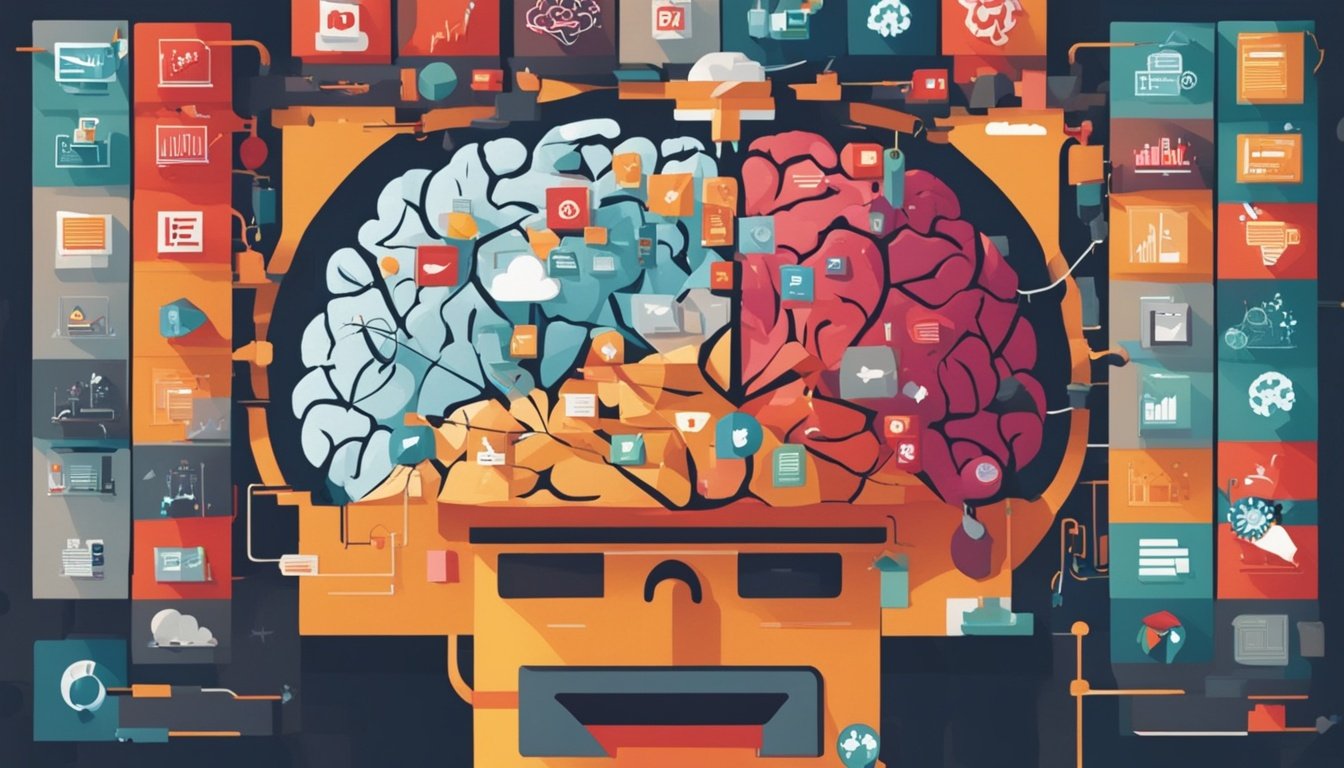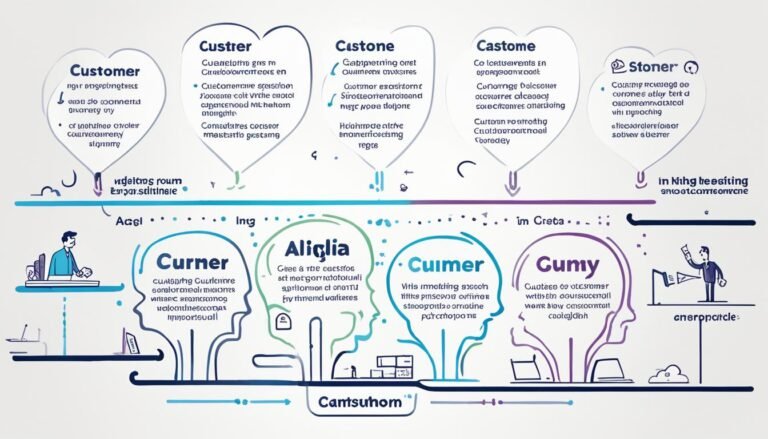How Neuromarketing is Changing Advertising
Did you know emotions are key in how we remember ads? Research shows that print ads make us feel more and stick in our minds better than online ones. This is part of neuromarketing, a new way to use brain science to change how we market things.
Forbes talks about how marketing has changed from old ways to new digital ones. Now, we’re using brain science to understand what consumers really want. This means looking into how our brains make choices, which is a big part of what we do every day. Tools like EEG and fMRI help us see how people react to ads, making marketing better and products more appealing. Let’s explore how neuromarketing is changing advertising.
Key Takeaways
- Neuromarketing combines neuroscience and marketing science to gain deeper insights into consumer behavior and brand perception.
- Subconscious decision-making accounts for 85% of consumer choices, making it a focal point for neuromarketing studies.
- Techniques like EEG, fMRI, and Eye-Tracking gather objective data, enhancing the effectiveness of marketing campaigns.
- Emotional engagement in ads is pivotal, as emotions are strongly linked to memory and decision-making.
- Future trends in neuromarketing might include integrating VR and AR to create immersive advertising experiences.
Introduction to Neuromarketing
Neuromarketing blends neuroscience with marketing to study how our brains react to ads and products. It looks at the parts of our choices we don’t even think about. Since 85% of our decisions are made without us realizing it, knowing what drives us is key.
Neuromarketing is different from old-school marketing, which relies on what people say they like. It uses tools like EEG and fMRI scans to see how our brains really react. Biometric marketing techniques like eye-tracking and facial emotion recognition measure our true feelings.
Recent breakthroughs in neuromarketing have changed how companies make choices. For example, ads that touch our feelings do 23% better than those that just share facts. This shows how important it is to connect with people on an emotional level.
Big names like Google and Microsoft have used neuromarketing to make their products better. They design with our brain’s responses in mind. This shows how neuromarketing can change how we make products and connect with customers.
“Neuromarketing provides profound insights into customer engagement,” notes a Nielsen report, “with techniques leveraging the neurological basis of emotions to craft more engaging and persuasive ads.”
Some high-tech tools for neuromarketing can be pricey. But, many companies are finding cheaper ways to understand and improve how people react to ads.
In short, combining neuroscience with marketing through biometric techniques is a game-changer. It helps us understand consumer behavior better, giving companies an edge in the fast-paced ad world.
The Science Behind Neuromarketing
Neuromarketing uses neuroscience to understand what makes consumers tick by looking at their brain responses. It’s a new way to study how people react to things, going beyond just asking them. By 2009, big names like Microsoft and Yahoo were already using this method.
Understanding Brain Activity
Neuromarketing focuses on studying the brain’s activity. Tools like EEG measure the brain’s electrical signals. This helps us see how people react to different things.
For example, a study showed different brain reactions when people paid with credit cards versus PayPal. By looking at brain waves, we can understand what people really feel.
Techniques and Tools in Neuromarketing
There are many new tools and methods that have changed how brands understand consumers. One key tool is Implicit Response Measurement, which catches feelings people can’t put into words. Eye-tracking also shows how people look at ads.
For instance, some Facebook ads got a lot of attention, showing the impact of good design. Another study linked anti-smoking ads to more calls to quit hotlines, proving neuromarketing’s power.
Brands like Chips Ahoy and Cheetos have used these technologies to improve their marketing. They found that print ads can touch people more deeply than online ones. This highlights the value of engaging with consumers in a physical way.
Benefits of Neuromarketing for Businesses
Neuromarketing helps businesses improve their marketing by looking into what consumers think without them realizing it. By using neuro-insights for branding, companies can understand what makes people decide to buy things. This helps them make ads that really stick with people.
Advertising effectiveness gets a big boost when ads are made with data from how people feel subconsciously. Thanks to new tech, neuromarketing labs are easier to find and use. Now, even small businesses can use these tools to get ahead.
Now, market research is faster and cheaper thanks to cheaper neuromarketing gear. What used to cost $50,000 now costs about $1,500. This means more companies can use neuromarketing to get neuro-insights for branding.
Companies can now track how people feel and react to ads. This helps them make ads that make people feel good and avoid those that don’t. The Human-to-Human (H2H) marketing method also gets better with neuromarketing insights.
Getting real data on what consumers like and dislike from a brain perspective is a big win for businesses. With clear, useful insights on advertising effectiveness, companies can make smarter choices. This leads to better products, more engaged customers, and loyal customers.
Neuromarketing Techniques
Neuromarketing uses special methods to study subconscious decision making and understand what customers want. These techniques help companies make their marketing better match what customers like.
EEG (Electroencephalography)
EEG is a key tool in neuromarketing. It measures brain activity in real-time. By using sensors on the scalp, it shows how people feel and think. This biometric analysis is key to seeing how people react to ads.
EEG works with eye-tracking to give even more detailed insights into what people think and feel.
fMRI (Functional Magnetic Resonance Imaging)
fMRI looks at brain blood flow to see how the brain reacts emotionally and cognitively. It’s not used as much because it’s expensive and hard to set up. But, it’s very important for understanding the brain’s complex workings.
This biometric analysis helps marketers make products and ads that touch people on a deep level.
Eye-Tracking and Facial Emotion Recognition
Eye-tracking shows where and how long people look at ads. It tells us what grabs their attention. When combined with facial emotion recognition, it shows how people feel about what they see.
This helps brands make ads that really speak to people on a deep level.
Insights into Consumer Behavior
Understanding what drives consumer behavior is key to making ads that really connect. Neuromarketing looks into the hidden factors that affect what we buy. It shows how emotions play a big part in our choices.
Subconscious Decision-Making
Tools like fMRI and EEG have changed how we see decision-making. fMRI shows which parts of the brain light up when we see ads. EEG tracks brain waves to see how engaged we are in the moment. These methods show that our feelings towards brands and ads can affect our choices without us even realizing it.
Emotional Responses
Ads work best when they touch our emotions. Eye-tracking helps spot what grabs our attention. By seeing where we look, marketers can fine-tune their ads to reach us on a deeper level.
Studies show that feelings like joy or surprise make us remember brands better. This is crucial for building loyalty. A study by neuroscientist Read Montague showed that brands can evoke strong feelings, proving emotions are key to remembering a brand.
Businesses need to use these insights to make ads that build stronger connections. This approach boosts engagement and keeps customers coming back.
Application of Neuromarketing in Advertising
Neuromarketing is changing the way ads are made. It uses design and brain science to make ads more effective. Research shows that 90-95 percent of buying decisions are swayed by these subtle cues.
Enhancing Ad Engagement
Ads that touch our feelings do 23 percent better than those that just share information. By tapping into brain science, ads can make us feel something strong. For example, eye-tracking shows what in an ad grabs our attention.
Also, up to 90 percent of what makes us buy something is because of color. Advertisers use this to draw us in with the right colors and stories.
Optimal Design and Placement
How ads look and where they appear matters a lot. Techniques like EEG measure how people react to ads in real-time. This helps make sure ads hit the mark every time.
Companies like Campbell’s Soup and Gerber have used this to make their packaging better. By tweaking their designs with neuromarketing insights, they’ve seen big improvements in how people respond.
Ads that use design and brain science connect with us on a deeper level. They stick with us longer and make a bigger impact. By using neuromarketing, advertisers can make ads that get us to act and stay loyal.
Neuromarketing and Digital Strategies
Technology keeps getting better, making it key for businesses to understand Digital Consumer Behavior. Neuromarketing helps by showing how people interact with digital stuff. It uses science from the brain, psychology, and marketing to make online presence better. This means focusing on Optimizing Website Design to keep users interested.
Tools like eye-tracking, EEG, and facial recognition are key in figuring out what consumers like. Eye-tracking shows what parts of a webpage grab attention. This helps brands put their most important stuff in the right spots for a big impact.
Companies like AVX Digital use these tools to check if their digital plans work. They look at where users look and how they react to things. This way, AVX makes sure web content gets the most engagement and turns visitors into customers. It makes websites match what people naturally prefer.
Neuromarketing also sheds light on Digital Consumer Behavior. Tools like fMRI and EEG watch how the brain reacts to digital stuff. They show how feelings affect online choices. Daniel Kahneman explains that quick, emotional decisions and careful thought both play a part in these choices.
Using neuromarketing in digital plans helps companies guess what consumers will do better. By reaching both emotional and logical parts of thinking, brands can make messages that hit home on many levels.
Ethics in Neuromarketing
Neuromarketing is changing how ads work, and we must think about its ethical sides. It’s key to respect people’s choices and be clear about what we’re doing with their data. Studies show how important neuromarketing is, like tracking eyes and measuring feelings. But, we must be careful not to misuse this powerful tool.
Respecting Participant Autonomy
It’s important that people know how their data will be used. In the world of research, getting consent is a big deal. But in marketing, it’s not always followed closely. Brands should tell people about how they’ll use their data and why they’re doing the research. This way, people trust them more and see that they care about being respectful.
Ensuring Data Privacy and Security
Data protection is a big worry in neuromarketing. Ads today use a lot of data, so keeping personal info safe is key. Following rules like GDPR helps protect against data breaches. Brands need to keep data safe and tell people about neuromarketing to avoid negative reactions.
Neuromarketing gives deep insights into what people want, but we must use it right. By being ethical, the industry can grow without losing trust or putting people’s data at risk.
Source Links
- From Brain to Brand: How Neuromarketing is Changing the Game for Print Marketers
- How neuromarketing is revolutionising advertising
- Why neuromarketing is essential for creating impactful ads
- Council Post: Neuromarketing: The Future Of Marketing Strategy
- How Neuromarketing Can Revolutionize the Marketing Industry [+Examples]
- The science behind neuromarketing campaigns.
- Neuromarketing: The science behind effective marketing
- What are the Benefits of Using Neuromarketing | Movers Development
- Neuromarketing: What You Need to Know
- The 10 Key Benefits of Neuromarketing
- The Future of Marketing: How Neuromarketing is Changing the Game
- What is Neuromarketing? Neuromarketing Techniques and Examples | The Chicago School
- What is Neuromarketing & How to Use It? | Neurons
- Neuro-Marketing Insights: Understanding Consumer Behavior on a Deeper Level
- The Science of Persuasion: How Neuromarketing is Changing Market Research – FasterCapital
- Neuromarketing: 15 Real-World Examples | Built In
- Neuromarketing for Digital Marketing | Mindspeller
- Neuromarketing Concept – To Change The Digital Marketing Strategies
- Digital Neuromarketing
- Advertising to the brain: The basics and ethics of neuromarketing
- When Neuromarketing Crosses the Line







